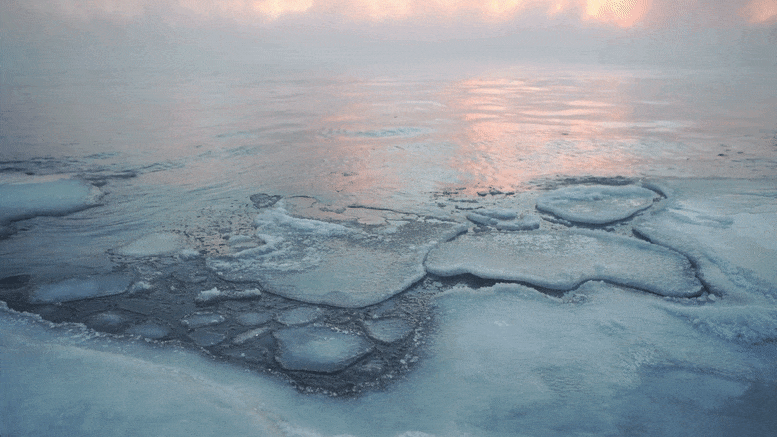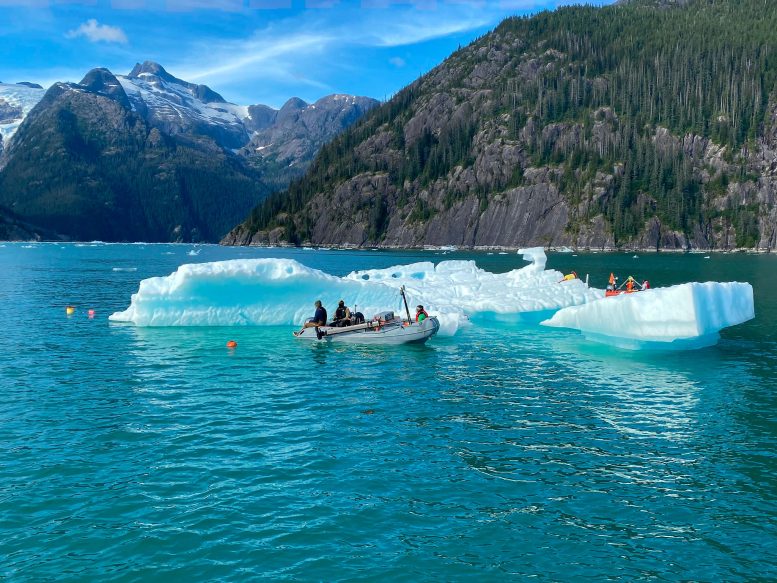
New research reveals that the bursting of tiny, pressurized bubbles in underwater glacier ice might explain why tidewater glaciers are retreating at remarkable rates. The study found that this bubbly glacier ice melts more than twice as fast as non-bubbly ice, suggesting the need to adjust current climate models which do not account for these bubbles.
Research from Oregon State University has discovered a potential reason for the rapid retreat of sea-terminating glaciers: the bursting of tiny, pressurized bubbles in underwater ice.
The findings, recently published in the journal Nature Geoscience is a monthly peer-reviewed scientific journal published by the Nature Publishing Group that covers all aspects of the Earth sciences, including theoretical research, modeling, and fieldwork. Other related work is also published in fields that include atmospheric sciences, geology, geophysics, climatology, oceanography, paleontology, and space science. It was established in January 2008.
” data-gt-translate-attributes=”[{[{“attribute”:”data-cmtooltip”, “format”:”html”}]”>Nature Geoscienceindicate that glacier ice, filled with pockets of pressurized air, melts significantly faster than sea ice without bubbles or the artificial ice commonly utilized to study melt rates at the ocean-ice interface of tidewater glaciers.
Tidewater glaciers are rapidly retreating, the authors say, resulting in ice mass loss in Greenland, the Antarctic Peninsula, and other glacierized regions around the globe.
“We have known for a while that glacier ice is full of bubbles,” said Meagan Wengrove, assistant professor of coastal engineering in the OSU College of Engineering and the leader of the study. “It was only when we started talking about the physics of the process that we realized those bubbles may be doing a lot more than just making noise underwater as the ice melts.”
Glacier ice results from the compaction of snow. Air pockets between snowflakes are trapped in pores between ice crystals as the ice makes its way from the upper layer of a glacier to deep inside it. There are about 200 bubbles per cubic centimeter, meaning glacier ice is about 10% air.
“These are the same bubbles that preserve ancient air studied in ice cores,” said co-author Erin Pettit, glaciologist and professor in the OSU College of Earth, Ocean, and Atmospheric Sciences. “The tiny bubbles can have very high pressures – sometimes up to 20 atmospheres, or 20 times normal atmospheric pressure at sea level.”

Glacier ice in LeConte Bay near Petersberg, Alaska. Credit: Oregon State University
When the bubbly ice reaches the interface with the ocean, the bubbles burst and create audible pops, she added.
“The existence of pressurized bubbles in glacier ice has been known for a long time but no studies have looked at their effect on melting where a glacier meets the ocean, even though bubbles are known to affect fluid mixing in multiple processes ranging from industrial to medical,” Wengrove said.
Lab-scale experiments performed in this study suggest bubbles may explain part of the difference between observed and predicted melt rates of tidewater glaciers, she said.
“The explosive bursts of those bubbles, and their buoyancy, energize the ocean boundary layer during melting,” Wengrove said.
That carries huge implications for the way ice melt is folded into climate models, especially those that deal with the upper 40 to 60 meters of the ocean – the researchers learned glacier ice melts more than twice as fast as ice with no bubbles.
“While we can measure the amount of overall ice loss from Greenland over the last decade and we can see the retreat of each glacier in satellite images, we rely on models to predict ice melt rates,” Pettit said. “The models currently used to predict ice melt at the ice-ocean interface of tidewater glaciers do not account for bubbles in glacier ice.”
Right now, data from ” data-gt-translate-attributes=”[{[{“attribute”:”data-cmtooltip”, “format”:”html”}]”>NASA attributes about 60% of sea level rise to meltwater from glaciers and ice sheets, the authors note. More accurate characterization of how ice melts will lead to better predictions of how quickly glaciers retreat, which is important because “it’s a lot more difficult for a community to plan for a 10-foot increase in water level than it is for a 1-foot increase,” Wengrove said.
“Those little bubbles may play an outsized role in understanding critical future climate scenarios,” she added.
Reference: “Melting of glacier ice enhanced by bursting air bubbles” by Meagan E. Wengrove, Erin C. Pettit, Jonathan D. Nash, Rebecca H. Jackson and Eric D. Skyllingstad, 7 September 2023, Nature Geoscience.
DOI: 10.1038/s41561-023-01262-8
The Keck Foundation, the National Science Foundation and the National Geographic Society funded the research, which also included Jonathan Nash and Eric Skyllingstad of the OSU College of Earth, Ocean, and Atmospheric Sciences and Rebecca Jackson of Rutgers University.

